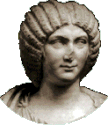Hairstyles
Each morning after the daily bath, an Ornatrix combed, crimped and styled her
mistress' hair, using pins, hair nets and ribbons. Hair dyes
are also applied at times; Pliny records a formula for black
hair dye that included leeches and vinegar!
Some recipes for hair bleaching and dyeing suvive, and
include a greasy formula called sapo from Germany to lighten
the hair. Others included pepper, rat's heads, even excrement.
It is reasonable to assume that these noxious formulae
necessitated donning a wig for some poor souls.
Hairdressing followed, in general, contemporary Greek
styles. From the latter part of the Republican era, however,
coiffures became increasingly elaborate and often unbeautiful.
It is said that in late Republican and Imperial times Roman
women bleached and dyed their hair and, moreover, wore false
blonde or red tresses taken from the heads of conquered
northern barbarian women.
 Characteristics of fashionable Imperial coiffures were: an
excessive amount, frequently disposed in braids, intricately
coiled; frizzing and curling; and high dressing in the front,
either with frizzed hair, in the manner that we know as
"pompadour," or with decorations of the diadem sort. Characteristics of fashionable Imperial coiffures were: an
excessive amount, frequently disposed in braids, intricately
coiled; frizzing and curling; and high dressing in the front,
either with frizzed hair, in the manner that we know as
"pompadour," or with decorations of the diadem sort.
 Note the
diadem arrangement on the portrait bust of
Marciana, (CE 95-117). The upstanding row of thick petals
appears in to be metallic, though in other similar coiffures
hair in tight cylindrical ringlets forms the diadem. A fringe
of frizzed hair conceals a narrow band and a "beau-catcher"
curl curves in front of the ear. The coiled braids are
arranged in a great cap at the crown of the head, and the hair
curls naturally and prettily in the nape. This is one of the
more attractive styles. Note the
diadem arrangement on the portrait bust of
Marciana, (CE 95-117). The upstanding row of thick petals
appears in to be metallic, though in other similar coiffures
hair in tight cylindrical ringlets forms the diadem. A fringe
of frizzed hair conceals a narrow band and a "beau-catcher"
curl curves in front of the ear. The coiled braids are
arranged in a great cap at the crown of the head, and the hair
curls naturally and prettily in the nape. This is one of the
more attractive styles.
 Pretty, too, is a portrait bust of
Julia Domna from the third century. Here her thick hair was marcelled and brought
back low behind her neck; all the long back-hair is braided and
interlaced in a basket-weave and pinned up at the back. Pretty, too, is a portrait bust of
Julia Domna from the third century. Here her thick hair was marcelled and brought
back low behind her neck; all the long back-hair is braided and
interlaced in a basket-weave and pinned up at the back.
A veil was added at will to any Roman
coiffure, often as a ritual accessory. As in Greek practice,
this was draped loosely over head and shoulders, not, as a
rule, bound to the head with a ribbon or circlet. Except with the veil and possibly, when travelling, with
the petasos or sun-hat, or the
cucculus, Roman women
did not cover their hair.
Sources: I CLAVDIA: Women
in Ancient Rome,
Updated
|
